












Mark Dodge, CMCA, AMS
Branch President and Chief Executive Officer Desert Resort Management – an Associa Company
ovember is upon us, and with it comes the close of budget season. The major work for the year is largely behind us, allowing us to turn our attention toward the holidays—a season of gratitude and reflection. I know I have much to be thankful for.
While not everyone may consider a calendar full of meetings and activities something to appreciate, I do. To me, it means I’m engaged in meaningful work—making a difference in the lives of my employees, the clients we serve, and through the many philanthropic endeavors I’m fortunate to be part of.
As we move into the holiday season, let’s not overlook the opportunities we have, both individually and as a chapter, to reach out to those who may need a little extra help this time of year. At our upcoming Sips and Shots event, we’re encouraging attendees to bring an unwrapped toy to donate to the Coachella Valley Rescue Mission. These toys will be distributed to families who may not have the means to provide extras for their families.
A heartfelt thank-you goes out to the Oktoberfiesta committee who organized another wonderful event. The Pro Landscape Nursery provided a beautiful setting for this time-honored tradition. Now, we look forward to a great fall afternoon at our 9-Hole Hoedown Golf Event on Friday, November 14, followed by our Annual Legal Update Program with CLAC Advocate Luis Brown on Friday, November 21.
As 2025 draws to a close, I find myself reflecting on the many accomplishments our chapter has achieved this year. While we had a slow start, the onboarding of Holly Smith as Executive Director in May has brought tremendous improvement to the operations of our chapter office. We’re already seeing the benefits of her leadership and look forward to continued growth as we “Go Boldly” into 2026.
We also introduced a key change this fall: renaming our Marketing Plan to the Sponsorship Plan, officially launched on October 2 following our Business Partner Appreciation Event on October 1. We hope this new tradition will continue to highlight just how much we value our business partners and all that they contribute to the success of our chapter.
The momentum we’ve built this year has set the stage for an even more exciting 2026. Our theme, “Go Boldly,” isn’t just a tagline—it’s a call to action for all of us to explore new ideas, strengthen our partnerships, and continue leading the way in our industry. Thank you for being part of this incredible journey. The best is yet to come!
Wishing you all a joyful and meaningful holiday season.
The Community Associations Institute – Coachella Valley Chapter (CAI-CV), established in 1983, is a nonprofit organization dedicated to serving the educational, business, and networking needs of community association professionals and homeowner leaders throughout the Coachella Valley. As part of an international organization, CAI-CV provides vital resources, training, and legislative advocacy to help homeowners associations (HOAs) operate effectively and responsibly. Our mission is to build better communities by equipping board members, community managers, and business partners with the knowledge and tools necessary to lead with confidence, make informed decisions, and foster thriving, well-managed neighborhoods. Membership is open to all who serve HOAs. Board members can enroll up to 15 members of their community, including the Board of Directors, committee chairs, and committee members, with one low fee. This offer also extends to cities or other governing agencies that would like to connect with CAI.
If you are a manager or business partner, CAI offers many opportunities for education and credentialing, including the Educated Business Partner distinction, multiple designations, and specialty credentials for community managers.
To inquire about membership, visit www.cai-cv.org/join, call (760) 3410559, or email admin@cai-cv.org
Members have access to our online directory, which contains contact information for all members within our chapter across all membership categories. Advertising opportunities are also available—please contact our office for details.
HOA Living is CAI-CV’s monthly magazine and the official publication of the chapter. Circulation is approximately 800 and growing. A digital copy is distributed free to all members, and a printed version is available with a paid subscription.
If you are interested in submitting an article or advertising, contact us at HOALiving@cai-cv.org.
GENERAL INQUIRIES
Email: admin@cai-cv.org
Phone: (760) 341-0559
CAI-CV, 49950 Jefferson, Suite 130-117 Indio, CA 92201
MEMBERSHIP INQUIRIES AND UPDATES
Membership status/renewals cai-info@caionline.org
Address or information changes addresschanges@caionline.org
Recruiter credit addresschanges@caionline.org
PRESIDENT
MARK DODGE, CMCA, AMS Branch President & CEO Associa – Desert Resort Management
PAST PRESIDENT
JULIE BALBINI, ESQ. Managing Attorney, CV Office, Fiore Racobs & Powers, A PLC
PRESIDENT ELECT
BRUCE LATTA, CMCA Manager, Indio Properties/President, Desert Cities HOA Council
SECRETARY
BG (RET) GUIDO PORTANTE
Director, Mira Vista at Mission Hills HOA
TREASURER
JOLEN ZEROSKI, CMCA VP, Regional Account Executive First Citizens Bank
DIRECTOR
CLINT ATHERTON, PCAM, LSM General Manager, Sun City Palm Desert
DIRECTOR
BRIAH CASTILLO, BUSINESS DEVELOPMENT Ivan’s Painting
DIRECTOR
MANDIE CHLARSON Principlal, NLB Consulting & Elections
DIRECTOR
MICHELLE LOPEZ, CMCA, AMS Director of Community Management, Powerstone Property Mgmt. DIRECTOR
LILY ORTEGA, CMCA Office Manager, Pro Landscape
DIRECTOR
MIKE TRAIDMAN
Treasurer, Mira Vista at Mission Hills HOA Commissioner, CAMICB
NATIONAL CONTACTS
National Corporate Member updates addresschanges@caionline.org
National Professional Directory
Laura Mason, lmason@caionline.org
Dues or multi-chapter additions cashprocessors@caionline.org
JENNIFER JAMES, ESQ. CHAIR
Partner & Managing Attorney of the Coachella Valley, Roseman Law, APC
ASHLEY LAYTON, CMCA, AMS, PCAM CO-CHAIR
Premier Community Association Management
MIKE TRAIDMAN
BOARD LIAISON
Mira Vista at Mission Hills HOA
SEAN ANDERSEN Association Reserves
FELICIA BUSTOS WICR Inc.
Waterproofing & Construction
SIERRA CARR, CMCA, AMS, CCAM, PCAM
Personalized Property Management
JOHNNY CONTRERAS
Southwest Landscape & Maintenance
ROBERTO ANTONIO FLORES Hidroklear LLC
JAY JARVIS
Homeowner Leader
MIRANDA LEGASPI
Platinum Security
JESSICA MCCONNELL HOA Invest
LILY ORTEGA
Pro Landscaping Inc.
BRITAIN ROME Allied Universal
JASON SAVLOV, ESQ. Adams | Stirling, PLC
DAVID SCHUKNECHT, AMS, PCAM, MBA Personalized Property Management
JOHN SCHUKNECHT, CMCA, AMS LaBarre/Oksnee Insurance
STEVEN SHUEY, PCAM Retired Community Manager
CHRIS SIGLER, B.S.C.E, CDT
C.L. Sigler & Associates, Inc.
CREATIVE DIRECTOR & GRAPHIC DESIGNER
RODNEY BISSELL
Bissell Design Studios, Inc. rodney@bisselldesign.com (714) 293-3749
PHOTOGRAPHY
MATTHEW LAWTON, CIC, CIRMS, EBP OCV Insurance Services matt@ocvinsurance.com 760-774-2099
JAY JARVIS Homeowner Leader jayj92260@gmail.com 571-235-5420
The opinions and views expressed in editorial material are those of the individual writer or interviewee and do not necessarily reflect those of CAI-CV, its Board of Directors, or its advertisers.
Unless specifically stated, CAI-CV does not endorse any person, political candidate, or opinion.
The materials in this publication are intended to provide timely, authoritative information to our members. However, CAI-CV does not provide legal, accounting, or other professional services. Readers are encouraged to seek advice from qualified professionals before acting on information contained herein.
HOA Living reserves the right to reject advertising submissions that do not meet our standards. For advertising guidelines, please contact CAI-CV staff.
All submissions are subject to editing for grammar, length, and appropriateness.
Advertisers, please note that print colors may vary slightly due to differences in the printing process.
THANK YOU
2025 CORPORATE SPONSORS
Associa Desert Resort Management
C.L. Sigler & Associates, Inc.
Fiore, Racobs & Powers, A PLC
Flood Response
Gardner Outdoor and Pool Remodeling
Hotwire Communications
Lloyd Pest Control
Signarama
AMS Paving, Inc.
BRS Roofing, Inc.
Cooper Coatings
EmpireWorks
First Citizens Bank
MC Builder Corp
Powerstone Property Management
Precision Painting & Reconstruction
Accurate Termite & Pest Control
Alan Smith Pool Plastering & Remodeling
Alliance Association Bank
Association Reserves
Banc of California
Charter Communications
Delphi Law Group
Dunn-Edwards, Corp
Epsten, APC
Horizon Lighting
Ivan’s Painting
NLB Consulting & Elections
Patrol Masters, Inc.
SCT Reserve Consultants
Sierra Dawn Estates HOA
Southwest Landscape & Maintenance
SouthWest Security
Sun King Electric, Inc.
Vista Paint Corporation

18 Fall 2025 Bill Brief
22 Smart Energy Choices for Cooler Months
30 November in the Coachella Valley: Preparing Your Landscape for the Season Ahead
Layers of Protection: Developing Community Association Security By
38 Protect your Sewer Pipes this Holiday Season By Coachella Valley Water District



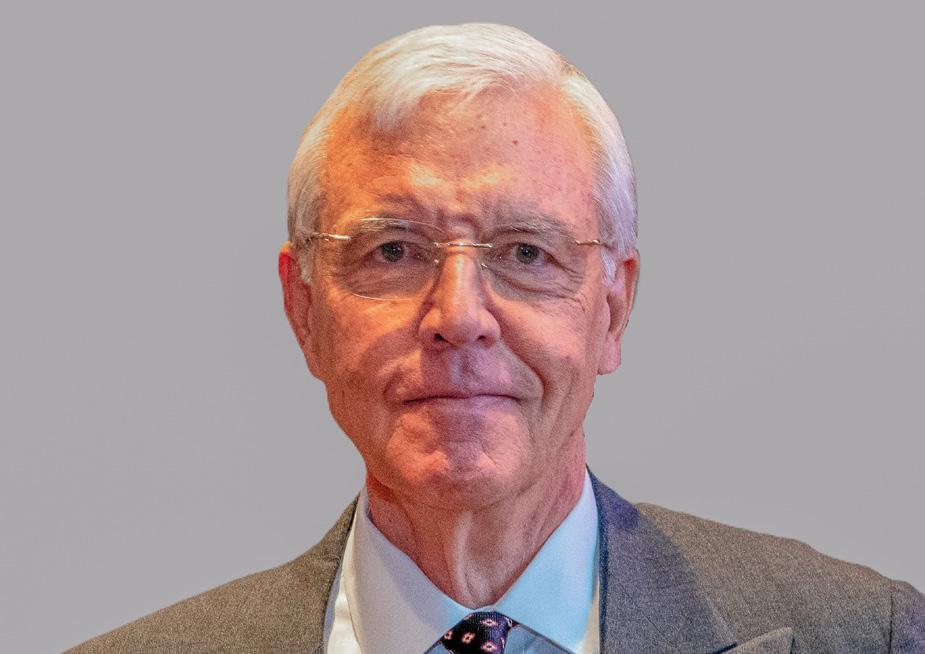











NEW BUSINESS PARTNERS
ASSOCIATION PRIME BY SOUTH STATE BANK
Ms. Melissa Spatafora (772) 408-5978 mspatafora@associationprime.com
AUTOMATION PRIDE
Mrs. Dana Pride (760) 423-6567 danapride@automationpride.com
DUNN-EDWARDS CORPORATION
Ms. Jessica Seitz (562) 760-9969 jessica.seitz@dunnedwards.com
EMPIREWORKS RECONSTRUCTION
Mr. Chet Oshiro (888) 278-8200 coshiro@empireworks.com
FLANAGAN LAW, APC
Mr. Tim Flanagan, Esq. (619) 489-1767 tim@flanaganhoalaw.com
LLOYD PEST CONTROL
Mr. Curtis Smith (760) 460-1181 curtis.smith@lloydpest.com
MARTIN SWEEPING/PRESSURE WASHING
Ms. Jasmine Garrison (760) 200-9510 jasmine@martinsweeping.com
SANCHEZ LANDSCAPING INC.
Mr. Jeff Sanchez (760) 272-7292 sanchezinc4@aol.com
TEM SYSTEMS/GATEHOUSE SOLUTIONS
Mr. Ryan Mcintosh (800) 777-8912 ryan.mcintosh@temsystems.com
ASSOCIA DESERT RESORT MANAGEMENT
Ms. Itzel Gastelum (760) 346-1161 IGastelum@drminternet.com
Ms. Deanna McLaughlin (760) 346-1161 dmclaughlin@drminternet.com
PERSONALIZED PROPERTY MANAGEMENT CO.
Mrs. Patricia Moeller (760) 325-9500 pmoeller@ppminternet.com
SUN CITY PALM DESERT COMMUNITY ASSOCIATION
Mr. George Boucher (760) 200-2107 george.boucher@scpdca.com
Ms. Jessica Castillo (760) 625-4558 jessica.castillo@scpdca.com
Mrs. Katie Rabago (760) 702-8008 katie.rabago@scpdca.com
ASSOCIA DESERT RESORT MANAGEMENT
Mrs. Brooke Ancheta, CMCA, AMS (760) 346-1161 bancheta@drminternet.com
Ms. Maryann Hoss, CMCA, AMS (760) 346-1161 mhoss@drminternet.com
Ms. Evelyn Juarez-Aceves (760) 346-1161 ejuarez@drminternet.com
Ms. Norma Segura (760) 346-1161 nsegura@drminternet.com
OUTDOOR RESORT PALM SPRINGS OWNERS ASSOCIATION
Mrs. Jennifer Miranda (760) 328-3834 ext. 300 jennifermiranda@gmail.com
PERSONALIZED PROPERTY MANAGEMENT CO.
Mr. Nicolas Evans, CMCA, AMS (760) 325-9500 ext. 246 nevans@ppminternet.com
SUNRISE COUNTRY CLUB HOMEOWNERS ASSOCIATION
Mr. Hale Kelly, CMCA (760) 328-6549 hkelly@sunrisecountryclub.com
THE GAFFNEY GROUP INC.
Mrs. Jacquelyn Smith (760) 327-0301 jackie@thegaffneygroup.net
Mr. Callen Lockett, CMCA callockett@outlook.com
Mrs. Sue Sweeney, CMCA, AMS, LSM, PCAM (760) 507-5709 thomasandsueare@yahoo.com
JACK IVEY RANCH HOMEOWNERS ASSOCIATION
Mr. Gregory Falk
Ms. Catherine Onishi
JACK IVEY RANCH HOMEOWNERS ASSOCIATION
Ms. Ana Duran
Ms. Kelly Maheu
RAMS HILL COMMUNITY ASSOCIATION
Mrs. Blythe Cavanaugh
Ms. Marie Downing
Ms. Ann Durham
Mr. Ted Gamble
Mr. Tim Gamble
Mr. Greg Jones
Ms. Jill Kennedy
Ms. Marcy Puhnaty
Mrs. Kerin Shugart
Mr. Mark Thomsen
Mr. Harry Turner
Mr. Daniel Zelec
Mr. Andrew Zimbaldi
Mr. Callen Lockett, CMCA


By David J. Schuknecht, AMS, PCAM, MBA

Founded in 1962 by the McIntyre family and promoted by Art Linkletter, Sierra Dawn Estates in Hemet was California's first master-planned retirement community allowing seniors to buy land and place manufactured homes—a model that transformed senior living.
Today, the 154-acre, 1,474-unit Sierra Dawn Estates is a case study in longterm value, strong finances, efficient operations, and stable leadership.
Unlike many underfunded communities, Sierra Dawn has strong finances and low resident fees.
With $1.8 million in reserves (68.42% funded) and monthly fees of $168, Sierra Dawn outperforms state averages in both reserve strength and affordability.
Comparable communities charge $300–$400 per month. Sierra Dawn residents pay about half, with better reserves and amenities.
Much of this success is credited to Community Manager Dan Goodrich, who has led Sierra Dawn for 28 years—a rarity in an industry with high turnover. The average community manager employed by management companies stays in their position for just 5 years. Individual résumés across the field typically show tenure of one to two years per community. Annual turnover rates in HOA management frequently exceed 30%, creating institutional knowledge gaps that cost associations dearly in both efficiency and resident satisfaction.
Goodrich’s long tenure brings deep knowledge, resident trust, and operational refinement to the community.
He holds top industry credentials, including the rare LSM designation for managing large, complex communities.
Goodrich credits strategic planning, informed by years of experience, for Sierra Dawn’s financial stability and low fees.
Sierra Dawn runs efficiently with about ten staff, outsourcing specialized tasks to trusted vendors instead of building large internal departments.
This approach brings expert oversight—legal, financial, and maintenance—without extra overhead costs.
Resident-run committees handle governance, planning, and special projects, engaging the community and distributing responsibility.
This lean structure enables impressive amenities—multiple clubhouses, pools, spas, fitness rooms, and more— while keeping costs low.

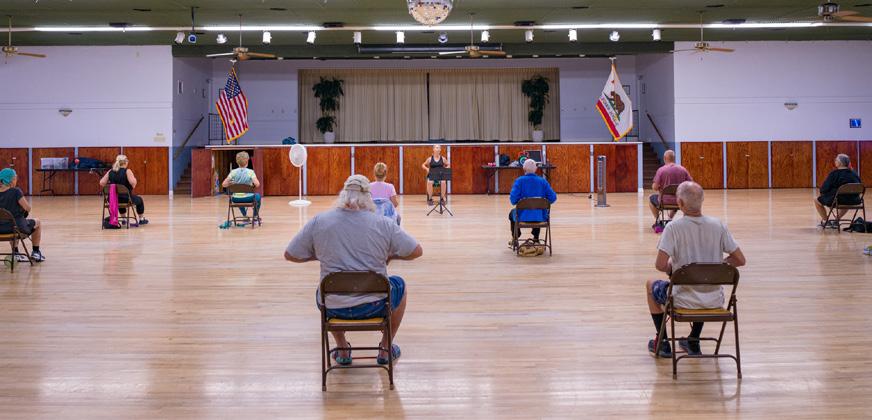
Recent capital projects demonstrate the community's ability to make strategic improvements without compromising financial stability.
Recent projects include a $600,000 bathhouse and a new recreation center with indoor pickleball courts, all paid for through reserves, not special assessments.
These improvements were fully funded by reserves due to disciplined planning.


While financial metrics and oper ational efficiency matter to industry professionals, they ultimately serve one purpose: creating an exceptional living environment.
Residents enjoy a lively schedule of activities, including crafts, games, clubs, and popular new pickleball courts.
Sierra Dawn offers both quiet living and convenient access to shopping and services.

Residents own their land, with homes typically priced between $150,000 and $300,000. The HOA owns and manages shared amenities.


Key takeaways for HOA professionals:
• Leadership continuity builds institutional knowledge, trust, and efficiency.
• Disciplined reserves allow for improvements without special assessments.
Art Linkletter’s early support helped establish Sierra Dawn’s reputation as a groundbreaking retirement community. The commitment to homeownership, community connection, and quality management remains central.
Despite statewide HOA challenges, Sierra Dawn shows that disciplined management and planning ensure sustainability.
The community faces the same external pressures as every association: rising vendor costs, regulatory compliance requirements, aging infrastructure, and the need to balance resident expectations with financial realities. The difference lies in how these challenges are addressed.
With strong reserves, low fees, and steady leadership, Sierra Dawn is well-positioned for the future.




Sierra Dawn Estates serves as a blueprint for sustainable, resident-focused HOA management.
Its success comes from consistent, smart decisions: hiring and retaining great management, building funding reserves, maintaining transparency, and making strategic investments.
Sierra Dawn proves the value of long-term planning in HOA communities.

David J. Schuknecht, AMS, PCAM, MBA is the Vice President of Personalized Property Management. With credentials including an MBA in Accounting from Louisiana State University and both AMS and PCAM designations, David combines strategic business acumen with deep industry expertise from his decade plus experience. His philosophy is simple: empower great managers with great tools, and they'll deliver great results for their communities. David can be reached at David@hoappm.com or (760) 325-9500.

THANK YOU FOR YOUR VOTE!
Here are the results for the board elections for the 2026-2028 term. The terms are effective as of January 1, 2026 where positions, will be determined at that time.








By
Bypassing a midnight timeline, on Saturday, September 13th the California Legislature adjourned the first year of the 2025-2026 Legislative Session. Hundreds of the remaining bills passed by the Senate and Assembly moved to be prepared for Governor Newsom’s review to be signed or vetoed. Governor Newsom has until October 13 to act.
The legislature has adjourned and will return on January 5, 2026, to begin the second year of the two-year legislative session. Bills that were made into two-year bills may be taken up at that time, but all measures must be acted upon by the end of next year. Here’s an update on where things currently stand:
SB 770 (Allen), would eliminate the requirement for HOA members installing EV chargers in common areas to name the association as an additional insured. Despite discussions with the Senator, we were unable to secure significant amendments before the deadline. The bill passed the Assembly and is now on the Governor’s desk, awaiting signature or veto. CAI-CLAC has submitted a veto request.
SB 625 (Wahab), proposes a streamlined architectural review process for rebuilding after natural disasters. After productive discussions, the bill’s scope was limited to actual disaster-related events, and CAI-CLAC moved to a neutral position. The bill passed the Assembly and is now on the Governor’s desk, awaiting signature or veto.
SB 547 (Perez), this bill adds commercial property with policy limits of $10,000,000 or more to the cancellation moratorium list. CAI-CLAC had a support position. The bill passed the Assembly and is now on the Governor’s desk, awaiting signature or veto.
SB 410 (Grayson), would require inspectors to include specific information on the cover page of balcony inspection reports. The bill passed Assembly Floor without further debate. The bill is now on the Governor’s desk awaiting, signature or veto.
SB 282 (Wiener), would void any CC&R that prohibits the installation of an electric heat pump. This bill was held in the Senate Appropriations Committee and did not move this session. However, it can be taken up when the legislature reconvenes in January 2026.
AB 942 (Calderon), would have reduced the contract for Net Energy Metering rates for those associations that installed solar from 20 years to 10 years. CAI-CLAC did not take an active position. The bill was referred to the Senate Appropriations Committee Suspense File and re-referred to the Senate Committee on Rules.
SB 681 (Wahab) / AB 130 (Committee on Budget), proposed a $100 cap on HOA fines, with an exception for violations that pose a health or safety risk. The bill was signed into law on June 30 and took effect immediately, requiring HOAs to revise their fine and enforcement policies. CAI-CLAC is already engaged in conversations on how to address these issues, which will be a top priority in the coming legislative session. Even though the Legislature is on recess, it is essential we continue to engage with lawmakers, apply pressure, and advocate for our communities. HOAs play a critical role in providing affordable, well-maintained, and community-oriented housing to millions of Californians, and we must ensure legislators understand their value and avoid unfairly targeting them.
If you haven’t already done so, you are encouraged to follow CAI-CLAC on Facebook, X, LinkedIn, Instagram and YouTube for ongoing news, resources, events and legislative action. AND, feel free to LIKE, SHARE and COMMENT on CAI-CLAC posts. This helps to spread our message and show the strength of our community.
By California Legislative Action Acmmittee For any questions call Wendy Van Messel, CMCA 916-791-4750 or office@caiclac.com

By the Legislative Support Committee
The “scourge” of 2025, it limits fines to $100 for most “violations” (unless they constitute a health and safety issue) and eliminated the penalty for all violations if the behavior or condition is “cured” before the board’s hearing. When Governor Newsom signed AB130, his intent was to fund California’s annual budget. However, as you’ve now learned, funding bills are effective immediately, and this is now California law! Practically speaking, using escalating fines to resolve legal conflicts has been eviscerated as a useful tool to resolve common enforcement issues.
Big Picture: Depending on how your community defines legal terms like “violations” “cured” and “health and safety”, your fining process will change, but the rest of the process will not: In most cases, the community already starts with a standard courtesy notice identifying the violation, followed a month or so later with a notice calling the owner to a fine hearing. Now, instead of a third notice and escalating fines, the legislature apparently wants the community to proceed directly to IDR, ADR, TRO or lawsuit as appropriate. Don’t forget, you still have amenity suspensions like pool or gym access or an automatic gate entry (make them plug in a code!) and, of course, towing folks who don’t follow parking rules.
SB 770 will amend Civil Code Section 4745 and seeks to remove the requirement that a homeowner installing an electric
vehicle charging station must add the HOA as an additional insured on their personal liability policy. Supporters of the bill argue that the insurance is not obtainable or at least presents an obstacle to installing EV chargers. Opponents, like CAI’s Legislative Action Committee, argue that removing the additional insured requirement shifts liability from the individual homeowner to the entire association. If an EV charger malfunctions and causes damage or a fire, the HOA's master insurance policy could be responsible, potentially driving up premiums for all homeowners, including those who do not have an EV. CAI also has provided evidence that major insurance carriers have been able to provide the necessary additional-insured certificates, contradicting the claims that the coverage is unavailable. As of October 2025, SB 770 was enrolled and is now awaiting the Governor’s signature.
The bill will amend several Civil Code sections, including Secs. 4525, 4528, 5200, 5210 and 5551. It will require HOA’s to provide the latest balcony and exterior elevated elements inspection reports (think SB 326) to prospective buyers in their sales disclosure documents. Aiming to increase transparency and safety for buyers and residents after the fatal Berkeley balcony collapse, the California Association of Real Estate supports the bill. The drafting engineers have opposed inclusion unless their entire report is disclosed. CAI had initially opposed the bill but supports it now that it was amended for our purposes. The bill was enrolled and awaits the Governor’s signature.

Responding to the insurance crisis, this bill allows for a one-year moratorium on insurance and non-renewals in ZIP codes affected by a declared wildfire state of emergency. The law applies to commercial properties, including specific residential or "habitational" types like apartment complexes, homeowners associations, condominium associations, and senior living facilities.
The "Reconstruction after Financial Damage" bill is aimed at helping homeowners and communities rebuild quickly after events such as wildfires. The bill has been chaptered and awaits the Governor’s signature. It does two major things:
1. Adds Civil Code § 4752 and states that any governing document provision that prohibits or includes conditions that have the effect of prohibiting reconstruction of a residential structure that was destroyed or damaged in a disaster is void and unenforceable. It also states that any owner who prevails in bringing an action to enforce Section 4752 shall be awarded reasonable attorney’s fees.
2. Also proposes to add Civil Code § 4766 to add specific procedures for architectural review of any application for the reconstruction of a residential structure that was destroyed or damaged in a disaster, including that applications must be reviewed and decided upon within 30 days of submission.
This bill expands discussions regarding use of (recycled) non-potable water for landscape irrigation and commercial uses. Part of California's goal to drought-proof the state using water recycling, it addresses treating wastewater to non-potable standards for future irrigation (not drinking)
uses. The bill adds further parameters to non-functional turf rules coming in 2029 from a water district near you.
News on the Cal-FAIR (Fire Insurance) Plan: As of a July 2024 agreement, the California FAIR Plan has increased its commercial property coverage limit to $20 million per Building, not to exceed 100 million. A proposed significant increase of upwards of 35% additional Fair Plan funding could further help ease the pressure many carriers are feeling – keep your eyes peeled for this!
AB21 (also known as the "Taxpayer Protection Act of 2025") addressed HOA management, meeting procedures and transparency. CAI and other industry groups opposed the bill, which died in committee on April 28, 2025.
AB 739 proposed that managers hold a broker license. Managers are presently required to disclose their certifications and licenses to the board but are not actually required to be so certified or licensed. AB 739 was designated as a "two-year bill" and will not be considered until 2026.
AB 942 would have reduced the contract for Net Energy Metering rates for those associations that installed solar from 20 years to 10 years. CAI-CLAC did not take an active position.
SB 282 would void any CC&R that prohibits the installation of an electric heat pump. This bill was held in the Senate Appropriations Committee and did not move this session. However, it can be taken up when the legislature reconvenes in January 2026.
SB 677 sought to overcome the legal interpretation following SB 9's passage that exempted HOAs from the law's lot-splitting requirements. CLAC Opposed this bill and it failed in committee.

By Legislative Support Committee for the San Diego Chapter of the Community Association Institute.
On Friday, October 17th, we kicked off our educational season with Kevin Kostka of Allan Smith Pools and Deborah McGarrey of Southern California Gas Company presenting Getting Your Pools Ready for Season. While much of the country prepares to winterize pools, our community gears up for peak usage!
We appreciate our speakers’ expertise and the chance to showcase Sun City Palm Desert’s newly renovated clubhouse—a highlight as we look forward to hosting our Awards Night there in January.
Special thanks to the behind-thescenes team—Trevor Blanton and Irma Lopez in Events Marketing and Catering, the lunch staff, and Perry Jeres and Javier Reynoso for audio-visual support—for making these events possible and ensuring each program runs smoothly.
Looking ahead, our next Educational Program will be on Friday, November 21st, at Sun City Palm Desert. Louis Brown, CLAC Delegate, Sandra Gottlieb of SwedelsonGottlieb Law, and Steven Roseman of Roseman Law, APC will provide our annual legal update and share key insights for 2026. This session will feature one of our largest Expos of the year—don’t miss the chance to connect with our business partners!
If you're looking for more pictures from this event, go to Preparing For Pool Season — October 2025 - CAICoachella Valley, where this and all our other event pictures are stored.
See you in November!
Guest Speaker Deborah McGarrey Southern California Gas Company
Guest Speaker Kevin Kostka Commercial Division Manager
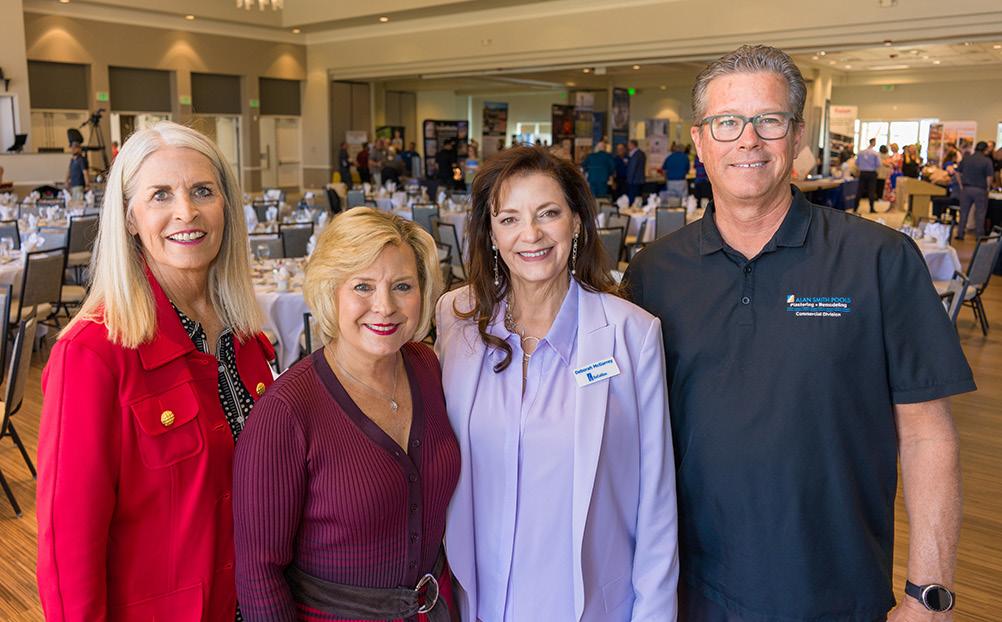




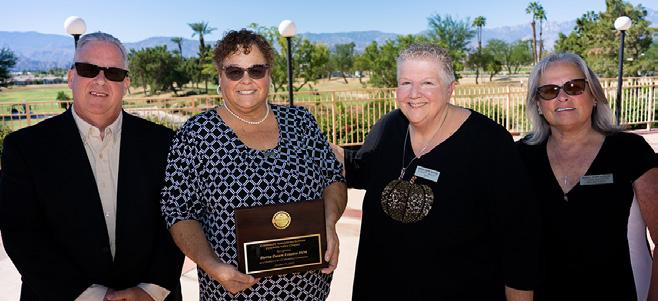










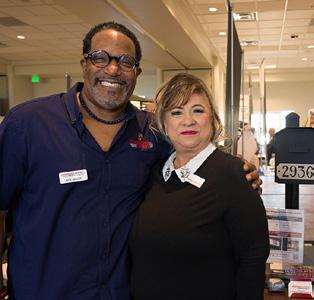























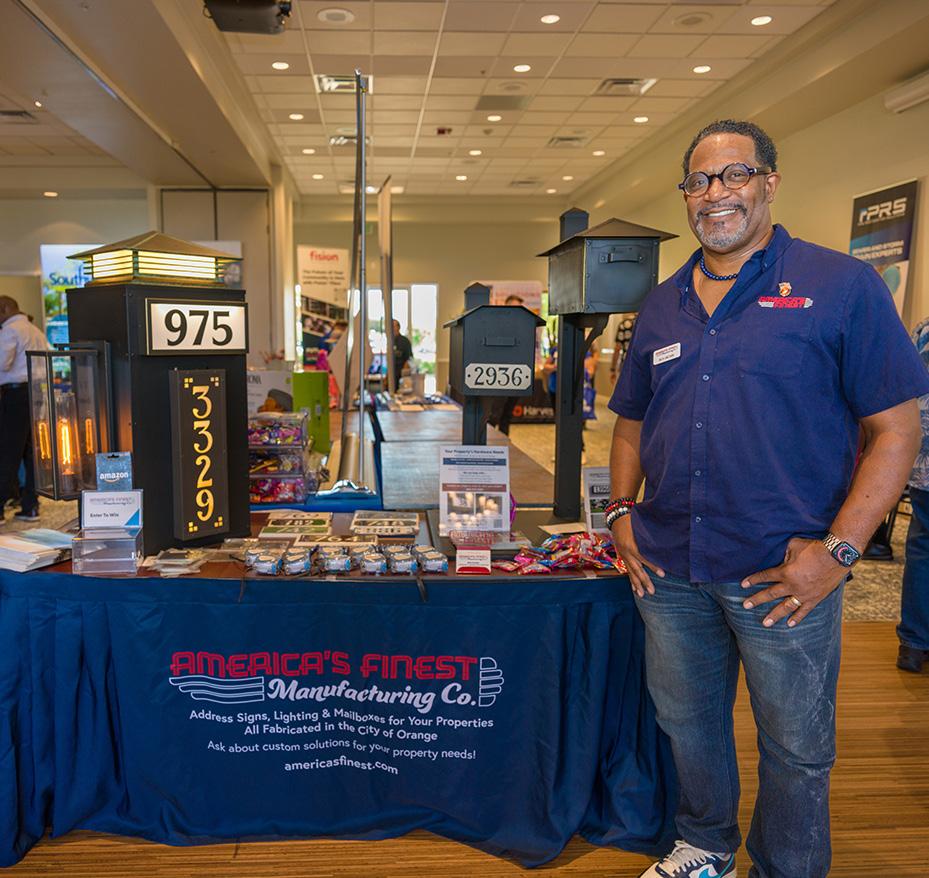
PROGRAM SPONSORS
Gardener Outdoor & Pool
Remodeling
PEN SPONSOR
Hidroklear, LLC
Accurate Termite and Pest Control
Action Property Management
Alliance Association Bank
America’s Finest Lighting and Mailbox Co.
AMS Paving, Inc.
Behr/Klz
Brown & Brown
BRS Roofing, Inc.
Dunn-Edwards Corporation
EmpireWorks Reconstruction and Painting
EntryOne
Gardener Outdoor & Pool Remodeling
Harvest Landscaping, Inc.
Hotwire Communications
Khatri International Inc.
Lloyd Pest Control
Mc Builder, Corp
NPG Asphalt
O’Connell Landscape
O’linn Security, Inc.
Pacific Western Bank
Patrol Masters
Pipe Restoration Solutions
Precision Painting & Reconstruction
Re-Bath
S.B.S. Lien Services
TGT Security THANK
SmartStreet Powered by BANC of Calif
Southwest Landscape & Maint LLC
By Roberto Antonio Flores
While community pools across California and the Southwest remain open year-round, November signals cooler days, higher gas bills, and lower bather loads. Many HOAs face a tough decision: whether to heat the pool or absorb the rising cost. The solution lies not in turning systems off, but in operating smarter—with efficiency, balance, and foresight.
Most energy loss in pools occurs not through water temperature, but through surface evaporation and outdated equipment. A properly fitted thermal pool cover can reduce heat loss by up to 70 percent. Variable-speed pumps, now standard in energy-efficient operation, can cut electrical consumption by half or more.
Routine inspection is equally critical. Scaled heat exchangers, obstructed filters, or air leaks in the plumbing increase gas consumption dramatically. Simple maintenance before the cooler months often translates into hundreds of dollars in monthly savings.
The most effective long-term strategy is adopting hybrid heating systems—a combination of solar or electric heat pump technology as the primary source, with gas backup for peak demand. This balance maintains comfort even during colder
days while significantly lowering operating costs.
California’s Title 24, Part 6 Energy Code now recognizes hybrid systems as the new efficiency standard. As of January 1, 2026, all new or replacement pool and spa heaters must use solar thermal or heat-pump systems as the primary heating method. Gas will remain allowed only as a supplemental or “boost” source. Forward-thinking communities that act now will not only reduce their carbon footprint but also ensure full compliance before the regulation takes effect.
Even when water temperature drops, chemistry control remains essential. Maintain pH between 7.4–7.6, chlorine 2–4 ppm, and alkalinity 80–120 ppm. Poor balance increases sanitizer demand, causes corrosion, and shortens equipment life.
Using phosphate removers and keeping cyanuric acid (CYA) around 20–40 ppm helps stabilize chlorine, preventing algae growth and keeping water visibly clean—hallmarks of proper management and community pride.
At Hidroklear, we encourage property managers and board members to view every pool as an investment in community wellness and long-term sustainability. Implementing high-efficiency technology, improving monitoring practices, and maintaining proper water chemistry are not expenses—they’re forms of risk management that preserve comfort, aesthetics, and property value.
Smart energy decisions made in November set the tone for the rest of the year. A balanced approach—combining hybrid heating, proactive maintenance, and disciplined water management— protects budgets, ensure compliance, and delivers the comfort residents expect.

Roberto Antonio Flores is President of Hidroklear LLC, a company dedicated to advancing sustainable, safe, and high-performance aquatic operations throughout the Americas. Roberto can be reached at (602) 617-4893 or sales@hidroklear.com


By John Schuknecht, CMCA, AMS
Every community has a set of governing documents: the CC&Rs, Bylaws, and Rules and Regulations. They’re the “how we live together” guide for the community. These documents exist to help the board of directors fulfill their responsibility to protect property values, keep things running smoothly, and ensure everyone understands their responsibilities. But they only work if they’re followed—and when they’re not, they must be enforced.
Consistently enforced rules and policies benefit the community. Buildings and property stay looking nice, and common areas are cared for. Problems start when enforcement is inconsistent or overlooked. It’s dangerous to let one neighbor off the hook for a violation while fining another, especially when life safety is involved. Over time, that can lead to frustration, tension, and even discrimination or legal headaches.
Here’s something many people don’t realize: ignoring or irregularly enforcing the rules can create liability issues for an HOA. Most associations carry professional liability insurance (also known as Directors and Officers Errors and Omissions, or D&O). This coverage helps protect the board if someone claims the board made a poor decision or failed to follow the governing documents. If a
homeowner believes the board failed to enforce the rules fairly—or at all—that could lead to a D&O claim.
And if the insurance company sees a pattern of the board ignoring its own responsibilities, coverage might be limited through endorsement or canceled upon renewal. In other words, being “nice” by letting a few things slide can backfire and put the association at financial risk.
"Enforcing your HOA’s governing documents isn’t just about keeping order—it’s about protecting your community. Fair and consistent enforcement keeps neighbors happy, property values strong, and insurance coverage reliable."
Insurance carriers also look at how well an association manages risk overall. A board of directors that applies its rules consistently and equitably, stays on top of maintenance, and keeps good records shows an insurance carrier that the board is responsible and focused on making the best decisions for the community. That kind of consistency can help an HOA maintain better insurance rates and coverage options. On the
other hand, association boards with a history of enforcement problems, frequent disputes, or deferred maintenance look risky—which can lead to higher premiums or fewer choices when it’s time to renew.
The good news is that avoiding these problems is simple: be consistent, be fair, and document everything. Make sure every homeowner understands the rules and the process for handling violations. Apply the same steps for everyone, every time, and keep written records of notices and board decisions.
At the end of the day, enforcing your HOA’s governing documents isn’t just about keeping order—it’s about protecting your community. Fair and consistent enforcement keeps neighbors happy, property values strong, and insurance coverage reliable. When everyone understands what’s expected of them, and the board sticks to correct practices, the whole neighborhood benefits.

John Schuknecht, CMCA, AMS, is a former community manager who currently works as an Account Executive for LaBarre/Oksnee Insurance. John can be reached at 657-207-4789 or JohnS@hoa-insurance.com
Since the passage of Assembly Bill 130, community associations throughout California have been reexamining how they enforce their governing documents. With fines now capped at $100 for most violations, many boards have expressed frustration that the law seems to strip away their primary tool for securing compliance. In practice, however, the board’s authority has not disappeared; it simply looks different than it once did.
One of the most common misconceptions since AB 130’s enactment is that fines are now the limit of a board’s power. That misunderstanding has emboldened some owners to view fines as a predictable cost of doing what they please. Recently, in one association, a homeowner submitted an architectural application for a major exterior alteration. When the application was denied as inconsistent with community standards, the owner’s response was, “Where can I send the $100?” The statement captured what many boards are now confronting: the perception that homeowners can ignore the rules for a $100 fee.
This, of course, is not how the law works. The monetary
By Jennifer James, Esq.
penalty is only one tool available to an association and does not diminish the board’s authority to enforce compliance through other legal means. Associations may bring actions for injunctive relief, which are court orders compelling an owner to comply with the governing documents, when voluntary compliance fails. The $100 cap limits fines, not enforcement.
For many associations, this means a renewed focus on proper documentation and process. Boards are finding that the disciplinary hearing now serves not only as a forum to decide whether to impose a fine but also as an opportunity to establish a clear record of notice, opportunity to cure, and ongoing noncompliance. This record becomes critical evidence if the association later seeks judicial enforcement (i.e. court action). Courts are generally receptive to well-documented cases that demonstrate the association acted reasonably and fol -
lowed the enforcement and due process procedures required under Civil Code Sections 5850 and 5855.
The new legal environment has also prompted more associations to pursue injunctive relief earlier, especially in cases involving anticipatory violations, unapproved construction, or conduct that threatens property values or safety. Boards are learning that prompt action, preferably before an owner completes a prohibited alteration, is far more effective than attempting to enforce compliance after the fact. Injunctions remain a powerful remedy, and associations that approach enforcement deliberately, with counsel’s



guidance, are finding that courts continue to uphold their authority when the record shows adherence to due process and an association’s internal enforcement procedures.
It is also important for boards to distinguish between enforcement and revenue. A fine is not a fee-for-use, and payment of a fine is not a license to violate the rules. The purpose of fines has always been to secure compliance and preserve community standards, not to punish or raise revenue. Boards should be transparent in communicating this distinction to their members. When owners understand that a fine does not entitle them to disregard the rules, and that continued or intentional violations can lead to legal action and liability for the association’s attorney’s fees, they are more likely to comply voluntarily.
"The purpose of enforcement has always been to secure compliance and preserve community standards, not to punish or collect income."
Although AB 130 has changed the way enforcement looks in practice, it has not diminished the obligation of boards to act. Effective enforcement now requires greater patience, more careful documentation, and sometimes a willingness to escalate enforcement earlier and pursue compliance through the courts. The associations that will adapt most successfully are those that treat enforcement as a process rather than a penalty, one rooted in fairness, consistency, and the understanding that protecting the community’s integrity remains the ultimate goal.

Jennifer James, Esq. is a partner and the managing attorney of the Coachella Valley office for Roseman Law, APC. A dedicated member of CAI for more than 20 years, Jennifer is a former CAI-CV Board member and currently serves as chair of the HOA Living Committee. She remains actively engaged in supporting and advancing the common interest community industry. She can be reached at James@Roseman.Law or (760) 760-2000.






By Felicia Bustos

CAI-CV is excited to welcome Pool Services Direct as our newest Business Partner Committee member and a valued new member of the community!
For more than a decade, Pool Services Direct has been a trusted partner to hotels, country clubs, and homeowner associations across the Coachella Valley, delivering high-quality pool chemicals and essential supplies at competitive prices. Their reliable, consistent service has earned them a strong reputation in the local pool industry and now they’re bringing even more to the table.
Their expanded services include ADA pool lift repair and replacement , helping communities stay compliant and accessible to all residents and guests. They also now offer professional water analysis with expert recommendations , so you can ensure your pools are always properly balanced, safe, and ready to enjoy year-round. Pool Services Direct makes it easy to maintain a pool that’s not only clean and beautiful, but also compliant with regulations and cost-effective to operate.
DIRECT:
• Cost-effective solutions without compromising on quality
• Fast, dependable service you can always count on
• A commitment to safety, compliance, and customer satisfaction
At the heart of the company is Jay Vasquez, who brings nearly 15 years of experience in the pool industry. Jay was born and raised in the Coachella Valley and understands the unique


needs of desert communities when it comes to pool care. Together with his wife, Laura, they run Pool Services Direct with a strong focus on building lasting relationships and providing friendly, responsive service. They can be reached directly at (760) 636-2086 or by email at info@poolservicesdirect.com.
Jay and Laura are proud parents to two middle school boys who play football for the PDLQ Roadrunners, and when they’re not working, you’ll often find them on the sidelines cheering them on. Their connection to the community is personal, and that same energy and care carries over into their business.
“I grew up here in the Coachella Valley and know how important it is to keep pools clean so everyone can enjoy a safe, happy space to relax,” says Jay. “Joining CAI-CV and serving on the Business Partner Committee is an exciting step for us. We’re passionate about supporting communities and look forward to getting to know you all.”
Please join us in giving a warm CAI-CV welcome to Jay, Laura, and the entire Pool Services Direct team we’re excited to have them on board and look forward to the value they’ll bring to our members and their communities!

Felicia Bustos is the Business and Development Liaison for WICR Inc. Waterproofing and Construction, serving the Coachella Valley and Inland Empire areas. She works closely with homeowners, HOAs, and property managers to ensure properties are ready for every season. Contact Felicia at Marketing@wicr.net or call 760-835-5674.






Across the Coachella Valley—home to iconic cities like Palm Springs, Rancho Mirage, and La Quinta—homeowners associations (HOAs) play a vital role in protecting the visual identity and long-term value of their communities. In a region known for its desert beauty, architectural charm, and resort-style living, consistent rule enforcement isn’t just a formality—it’s a cornerstone of community preservation.
The Coachella Valley has a unique aesthetic: desert-friendly landscaping, modern and traditional architectural styles, and outdoor living spaces that serve as an extension of the home. But when HOA rules aren’t enforced, small violations can quickly snowball into visible signs of decline.
INCLUDE:
• Overgrown or neglected landscaping
• Unapproved exterior paint colors
• Improper decking repairs or worn-out patio structures
• Visible clutter or storage
• Faded, damaged, or noncompliant deck finishes
While these may seem like minor issues, they stand out in well-maintained communities—especially in areas where outdoor spaces are part of the lifestyle and visual appeal.
By Felicia Bustos
Outdoor living is a year-round expectation in the desert, making decks, patios, and balconies high-visibility features. Inconsistent deck maintenance—such as peeling paint, damaged wood, or unapproved designs—can quickly detract from the community's overall image.
That’s why many HOAs include decking in their architectural guidelines, requiring:
• Approved materials and finishes
• Regular maintenance or repainting
• Permit and design review for any rebuilds or major modifications
A clean, uniform look across outdoor spaces doesn’t just improve aesthetics—it reinforces property value and ensures long-term durability in the desert climate.

“Consistent rule enforcement isn’t just a formality—it’s a cornerstone of community preservation.”
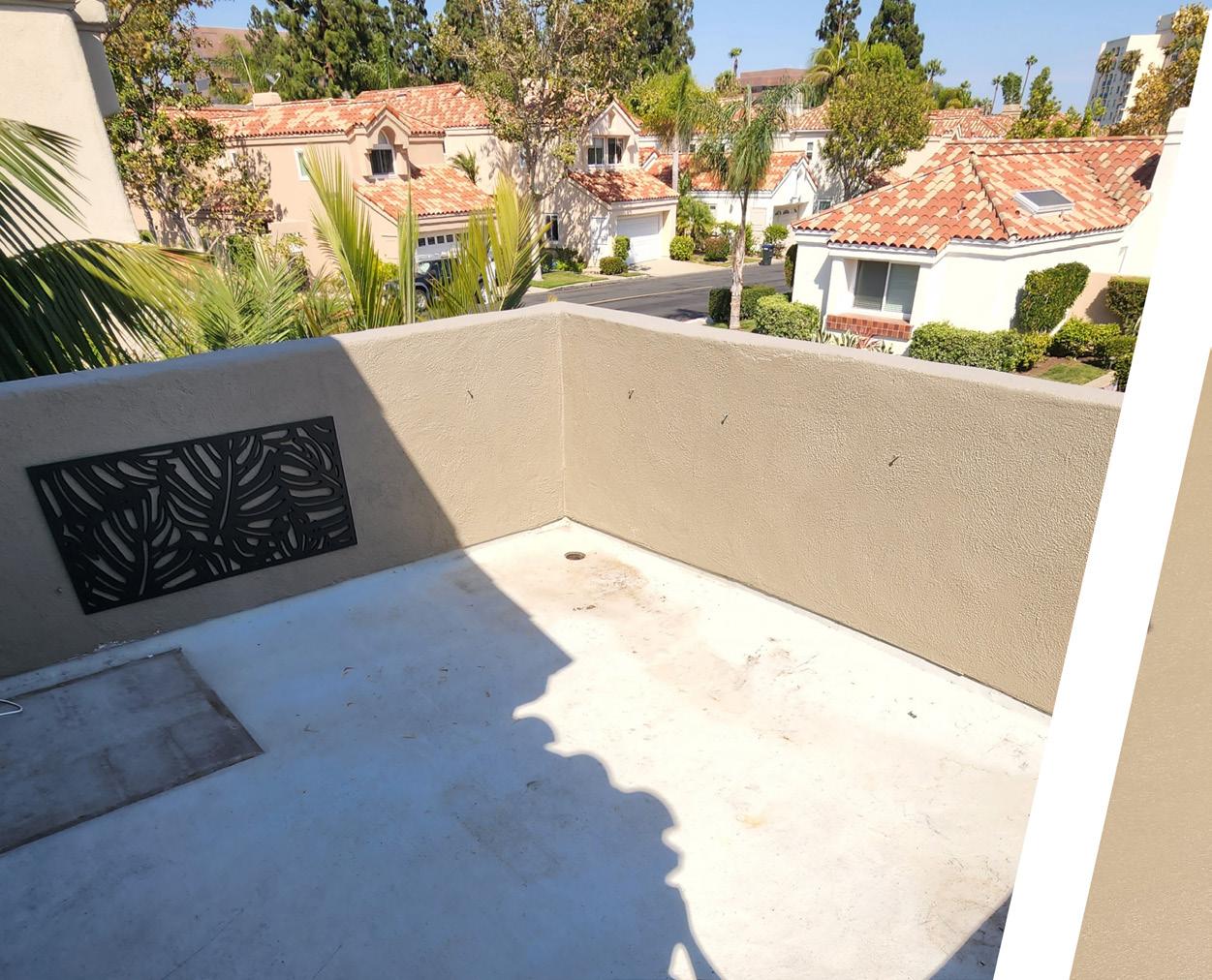
Coachella Valley buyers are often second-home seekers, snowbirds, or investment buyers looking for properties with minimal upkeep and strong curb appeal. Neighborhoods that enforce rules consistently—especially regarding outdoor spaces—enjoy:
• Higher resale value
• Greater buyer interest
• A more cohesive, highend appearance
On the flip side, communities where decks are left to weather, landscaping dries out, or paint jobs fade often struggle to compete, even in hot markets.
Many communities in the Coachella Valley see a drop in full-time residents during the summer. But enforcement needs to continue year-round. Summer heat and sun are hard on outdoor materials like decking, paint, and landscaping—making consistent oversight even more critical.
HOAs that maintain strong seasonal inspections and communication help preserve the community’s image and avoid last-minute repairs when seasonal residents return.

“A clean, uniform look across outdoor spaces doesn’t just improve aesthetics—it reinforces property value and ensures long-term durability.”

Ultimately, enforcement isn’t about micromanaging—it’s about protecting every homeowner’s investment. When rules are applied fairly and consistently, the benefits are shared:
• Stronger home values
• Greater pride of ownership
• Stronger community cohesion
• Better resale opportunities
Clear communication about decking requirements, landscaping expectations, and architectural consistency can help avoid conflict and ensure everyone is on the same page.
In the Coachella Valley, where outdoor living, visual appeal, and lifestyle are
“Ultimately, enforcement isn’t about micromanaging— it’s about protecting every homeowner’s investment.”
so closely tied to home value, HOA enforcement plays a critical role in protecting what residents love about their communities.
Whether it’s maintaining healthy landscaping, resealing faded decks, or upholding architectural standards, these efforts contribute to a community that is not only beautiful—but built to last.

Felicia Bustos is the Business and Development Liaison for WICR Inc. Waterproofing and Construction, serving the Coachella Valley and Inland Empire areas. She works closely with homeowners, HOAs, and property managers to ensure properties are ready for every season. Contact Felicia at Marketing@wicr.net or call 760-835-5674.
By Lily Ortega
As we roll into November here in the Coachella Valley, we can finally say goodbye to the scorching summer heat and hello to the season that makes desert living worthwhile. The mornings are crisp, the afternoons are comfortable, and homeowners start spending more time outside again. For those of us who work in landscaping, this is the sweet spot of the year—when the real transformation happens.
If you’re part of an HOA community, now is the time to shift your landscape from “survival mode” to “showtime.” The fall-to-winter transition in the desert is unique, and understanding how to handle it correctly will keep your community looking sharp all season long.
OVERSEEDING AND LAWN RECOVERY
If your community still maintains ryegrass lawns for that lush green winter look, November is the tail end of overseeding season. Ideally, the process should be done by late October, but it’s not too late if temperatures cooperate. The key is patience: give your seed plenty of water and avoid mowing too early. The first mow should happen when the grass blades reach about 3 inches tall.
One mistake I see often is cutting the water too soon after germination. Remember, even though daytime highs may only be in the 80s, those young
seedlings still need consistent moisture. After the lawn fills in, gradually back off on watering frequency but increase the duration slightly. This helps the roots grow deeper, which means stronger turf through the cooler months.
Many homeowners forget that plants don’t drink as much in the cooler months. With shorter days and lower temperatures, evaporation drops dramatically. If your irrigation controller hasn’t been updated since summer, you’re likely overwatering—and wasting money.
For drip systems, a good rule of thumb is to cut watering times by about 30–40%. Lawns can usually go from daily
watering to every 2–3 days, depending on sun exposure and wind. This small adjustment can save thousands of gallons of water each month across an HOA community.
If you don’t already have smart irrigation controllers, now is the time to consider them. They automatically adjust watering based on weather and soil moisture. Many water districts here in the Coachella Valley even offer rebates to help offset the cost.
Fall is also planting season in the desert. Cooler nights and mild days give new plants a chance to establish roots before the chilly months arrive. Native

"IF YOUR COMMUNITY STILL MAINTAINS RYEGRASS LAWNS FOR THAT LUSH GREEN WINTER LOOK, NOVEMBER IS THE TAIL END OF OVERSEEDING SEASON."

"FOR DRIP SYSTEMS, A GOOD RULE OF THUMB IS TO CUT WATERING TIMES BY ABOUT 30–40%."
and desert-adapted plants—like lantana, Texas ranger, and red yucca—thrive when planted now.
Fertilizer needs change in fall. For lawns, use a balanced or slow-release formula designed for cooler weather. You’re not trying to push fast growth—instead, focus on strengthening roots and maintaining color. For shrubs and trees, a light feeding now will carry them through the winter months.
November in the Coachella Valley is about transition— moving from the extremes of summer to the comfort of our best weather. With a few adjustments and a bit of proactive maintenance, your community can enjoy lush, colorful landscapes all winter long.

Lily Ortega is the Business Development Manager for Pro Landscaping Inc. and she also currently serves on the CAI-CV Board of Directors. Pro Landscaping Inc. is a leading landscaping company in the Coachella Valley. Please contact Lily at lily@proland-inc.com for more information.









By Mike Traidman
Today, we profile Board Member and board president-elect Bruce Latta. Bruce has served on the Desert Cities HOA Council board and several of the CAI-CV chapter committees, including as chair of the CAI-CV Homeowner Leader Committee. He was previously given CAI-CV awards that included the Above and Beyond and the Coachella Valley Homeowner Leader of the Year. He has also completed CAI's national board member certification. Bruce recently served four years on the board of directors of the Parc La Quinta Homeowners Association, and as board president for two of those years. Bruce was born and raised in Azusa, in the San Gabriel Valley suburbs of Los Angeles. He came to the Coachella Valley in 1994 to take a new job and has lived here since. He and his wife, Wanda, live in Parc La Quinta, a gated community of 150 single-family homes. They have three grown children.
Bruce received his BA degree in political science from Cal State University, Los Angeles. He also has several certifications, including Meetings and Event Planning from San Diego State University Extension, and another in Customer Service from College of the Desert. Bruce also holds the CAI's Certified Manager of Community Associations (CMCA) certificate.
Bruce's management career included working for almost twenty-five years in the fair, festival, and events industry as a manager. He was the Operations Department Manager at the Los Angeles County Fair. Governor Pete Wilson later appointed him as the Program Manager for the California State Fair. Locally, he served as the manager of the Riverside County Fair and National Date Festival and the Indio International Tamale Festival. He worked for the U.S. Department of Commerce on the

“Bruce also holds the CAI’s Certified Manager of Community Associations (CMCA) certificate. ”
2010 census as a field supervisor and then started his property management career. Subsequently, in 2008-09 when he worked for a commercial land developer, as the initial manager for a new development project organizing the three CIDs, the Jackson and Monroe Master, Commercial, and Residential Associations. Bruce has also served in two elected positions — two terms on the Citrus Community College Board of Trustees and following that, two terms on the Azusa City Council.
Currently, Bruce is a sole proprietor and provides commercial property management services. His client is a commercial land developer in Indio. Bruce said, "My services and duties vary and include just about anything that affects the properties, including proper maintenance, signage, creating some marketing, advertising, and promotions, representing the client with city and county government agencies, and addressing code enforcement citation issues such as cleanup of illegal dumping or homeless camping.
When asked about his most significant professional achievement, Bruce
gave a couple of interesting examples. He organized a community group in Azusa to obtain paramedics for the community. The group circulated petitions and qualified an initiative for the local ballot. It called for merging the city's fire department with the County of LA's to have paramedic services. It would also reduce the city's fire service costs. It was approved by sixty percent of the voters.
When operations manager for the LA County Fair, Bruce, tells of how the large weekend crowds could be a little overwhelming. He assisted in forming and chaired a traffic control committee, which included the fair's staff and all government agencies affected. It met and planned for months. The following year's fair's busiest Saturday, "we parked 50,000 vehicles, and there were over 170,000 people on the grounds that day. We got them in, entertained them, fed them, and sent them home with hardly a glitch."
When not busy with clients or CAI, Bruce has been an active member of the Indio Rotary Club community service organization for 30 years. Bruce said he first joined CAI-CV as an association manager for the educational opportunities and, more recently, as a homeowner leader member for the educational opportunities to understand his role as a board member better and to perform his duties to the best of his ability, and now he is a CAI-CV Board member and president-elect. Thank you, Bruce, for your continued service to CAI-CV.

Mike Traidman is a Director of CAI-CV, the Treasurer of Mira Vista at Mission Hills HOA, and a Commissioner for the Community Association Managers International Certification Board (CAMICB). Mike can be reached at mtraidman@yahoo.com.


By Britain L. Rome
When homeowners take on volunteer roles within their community association, they quickly find themselves learning about a wide range of topics – security being one of the most vital. People responsible for safety initiatives often start with one clear goal in mind: create a secure and welcoming environment for everyone in the neighborhood. Figuring out how to get there? That can be the tricky part.
In newer communities, associations might lean on past, positive experiences to help shape their security approach. In more established neighborhoods, there's sometimes a tendency to stick with a “how it’s always been done” approach. Regardless of a community’s age or makeup, association board members and homeowners alike need to understand one essential truth: security should be a top priority for every community, no matter how upscale or quiet it may seem.
Gone are the days when safety was only a concern in highcrime areas. Today, every neighborhood (large or small, urban or suburban) needs a thoughtful, comprehensive security strategy. Fortunately, there are many tools and techniques available to help accomplish this. From security personnel and surveillance systems to well-planned lighting and strategic landscaping, communities have options.
The best place to begin? With a trusted security partner that understands your unique needs – not just what boosts their bottom line. Even small changes, like repositioning a front desk for better visibility, can significantly improve overall safety. The key is evaluating your current setup and identifying what can be enhanced.
While every community is different in layout, size and design, some security principles are universal. A truly effective security plan includes a mix of personnel, technology, community engagement and layered protection. These layers can and should exist in every community, no matter how big or small.
This layer includes features that protect the outer perimeter of the community: fences, barriers, signage, lighting, gate systems, patrols and perimeter monitoring. Design strategies, like crime prevention through environmental design (CPTED), are especially useful here.

The middle layer focuses on entry points and common areas. This may include entry gates staffed by people, access-controlled buildings, CCTV systems, secure package delivery zones, and visitor management systems. It also covers spaces that are often overlooked like storage areas, utility closets and maintenance sheds.

This is the most critical layer of security. It includes measures like secure locks on home doors, controlled access to parking areas, interior patrols, motion-detecting lighting, and clear emergency protocols. This layer directly safeguards residents and their property.
Keep in mind, security features often overlap between layers. For example, patrols, lighting and surveillance cameras can support all three layers of protection. No single element can carry the entire burden; strength comes from building a network of visible and behind-the-scenes measures that work together to deter, detect and respond to threats.
Security doesn’t only mean preventing break-ins. It also includes preparedness for natural disasters, utility failures and other emergencies. A fallen tree blocking the only exit or a flood from an overflowing drainage system can be just as disruptive and dangerous as a break-in.
That’s why communication and contingency planning are key. Whether it’s establishing evacuation procedures or ensuring someone can respond to a power outage, security programs should cover a broad range of scenarios. Security staff often serve as first responders in these cases, so training and preparedness are also essential.
Effective security isn’t just about systems and technology – it’s also about people. Strong communication between homeowners, board members and security professionals makes a huge difference. Residents should feel comfortable reporting suspicious activity and security professionals should be encouraged to build positive relationships within the community.
Encouraging non-board member homeowners to get involved through newsletters, safety events and volunteer opportunities fosters a culture of shared responsibility. Security isn’t just the job of the board or security professionals; it’s a community-wide effort.

Creating a relationship with local law enforcement and emergency services adds another valuable layer. These partnerships help ensure your community is aligned with broader public safety efforts and can enhance training and awareness programs. Invite local first responders to community meetings or events, keep them informed about your security plans and collaborate on initiatives. Their insight and presence can make your efforts even more effective.
Lastly, don’t assume your security plan is a one-and-done deal. It’s vital to regularly review and update your plan. What worked well six months ago might not be effective today. Assess changes, track performance and make adjustments as needed to stay ahead of potential risks.
Security in a residential community is never about just one solution, it’s about building a strong, layered approach that reflects your community’s unique needs. With proactive planning, engaged residents, reliable partners and a commitment to continuous improvement, you can create a safer, more connected place for everyone to call home.

Britain L. Rome is the Business Development Manager with the Inland Empire Division, Allied Universal® Security Services. You can reach Britain at Britain.rome@aus.com or call (714) 453-7450.




GAME SPONSORS
AD MAGELLAN
AMS PAVING, INC.
EMPIREWORKS RECONSTRUCTION AND PAINTING
FLOOD RESPONSE
NLB CONSULTING
RE-BATH OF PALM SPRINGS
SOUTHWEST LANDSCAPE & MAINT LLC
STEIN SPONSORS
C.L. SIGLER & ASSOCIATES
T-SHIRT SPONSORS
ASSOCIATION RESERVES
FIORE RACOBS & POWERS A PLC
PHOTO SPONSORS
BEHR/KILZ
FIORE RACOBS & POWERS A PLC
SOUTHWEST SECURITY
COACHELLA VALLEY PUBLIC SAFETY
DJ SPONSOR
HARVEST LANDSCAPE
COACHELLA VALLEY PUBLIC SAFETY
GREETING SPONSOR
NISSHO OF CALIFORNIA, INC.
FOOD SPONSORS
DUNN-EDWARDS CORPORATION
HORIZON LIGHTING, INC.
SIERRA DAWN ESTATES HOA
DESSERT SPONSORS
O’CONNELL LANDSCAPE MAINTENANCE
SUN KING ELECTRIC, INC.
RESERVED TABLE SPONSORS
ASSOCIA DESERT RESORT MANAGEMENT
PRECISION PAINTING & RECONSTRUCTION
MCKENZIE MENA, LLP











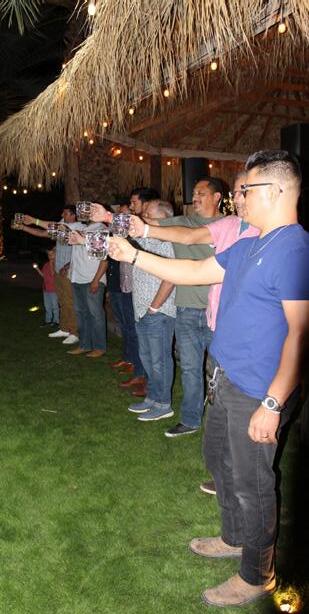


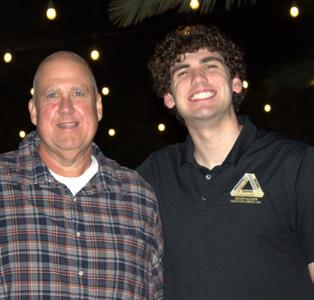





THANK YOU!
TITLE SPONSOR
Hotwire Communications
GAME SPONSORS
AD Magellan
AMS Paving, Inc.
EmpireWorks
Reconstruction and Painting
Flood Response
NLB Consulting
Re-Bath of Palm Springs
Southwest Landscape & Maint LLC
STEIN SPONSOR
C.L. Sigler & Associates
T-SHIRT SPONSORS
Association Reserves
Fiore Racobs & Powers A PLC
PHOTO SPONSORS
Behr/Kilz
Fiore Racobs & Powers A PLC
Southwest Security
GREETING SPONSOR
Nissho of California, Inc.
FOOD SPONSORS
Dunn-Edwards Corporation
Horizon Lighting, Inc.
Sierra Dawn Estates HOA
DESSERT SPONSORS
O’Connell Landscape Maintenance
Platinum Security
Sun King Electric, Inc.
RESERVED TABLE SPONSORS
Associa Desert Resort Management
Precision Painting & Reconstruction
By Coachella Valley Water District (CVWD)

The holidays are almost here, which means festive meals, sweet treats, and cherished recipes are all on the menu. While delicious, these beloved recipes may involve the use of fats, oils, and grease (FOG), which pose a serious threat to your plumbing and can cause costly damage to your sewer pipes.
When FOG is poured down the drain while still hot, it flows easily. However, as it cools, it begins to solidify and can quickly clog your pipes, leading to blockages, backups, and sewer overflows on your property.
Once within the community sewer system, FOG can create large fatbergs that stick to the inside of sewer pipes. A fatberg is a solid mass formed by the accumulation of non-biodegradable materials, such as wet wipes, paper towels, and grease. This buildup not only decreases the capacity of the wastewater collection system but also reduces its efficiency.
Avoid this situation by practicing proper FOG disposal during the food preparation process and kitchen clean-up.
By following these tips, you can help protect your home’s drains and pipes and ensure the community sewer system functions effectively. For more information, visit cvwd.org.
To learn more about wise water use in the Coachella Valley, visit cvwd.org/conservation.
• Bacon grease
• Pan drippings
• Butter
• Milk & creams
• Mayonnaise
• Cooking oil
• Sauces and gravy
• Salad dressing
• Peanut butter
• Never put FOG down the garbage disposal.
• Use sink strainers to catch food waste.
• Before washing, use a paper napkin or paper towel to wipe FOG from dishes and dispose of it in the trash.
• Pour cooled FOG into a container like an old food can or jar and put the container in the trash.


Julie R. Balbini, Esq., Fiore Racobs & Powers, A PLC
Micha Ballesteros, Cartwright Termite & Pest Control, Inc.
Roxi K. Bardwell, Advanced Reserve Solutions, Inc.
Rodney Bissell, Bissell Design Studios, Inc.
Gary Butler, Asphalt MD's
Linda Cardoza, Alliance Association Bank
Will Cartwright, Cartwright Termite & Pest Control, Inc.
Christopher Cellini, Flood Response
Todd Chism, PatioShoppers
DJ Conlon, Poppin Promotional Products
Lori Fahnestock, Powerful Pest Management
Julie Frazier, Frazier Pest Control, Inc.
Victoria Germyn, Teserra
Elaine Gower, The Naumann Law Firm, PC
Michael Graves, SCT Reserve Consultants
Amanda Gray, Harvest Landscape, Inc.
Jennifer James, Esq., Roseman Law, APC
Jennifer Felder, Platinum Security
Erin Kelly, Banc of California
Megan Kirkpatrick, Kirkpatrick Landscaping Services
Jared Knight, Precision Construction & Painting
Katy Krupp, Fenton Grant Mayfield Kaneda & Litt, LLP
Matt Lawton, CIC, CIRMS, OCV Insurance Services
Larry Layton, Kirkpatrick Landscaping Services
Alison LeBoeuf, Sherwin-Williams
Mike Mastropietro, OCBS, Inc.
Chris Meyer, Asphalt MD's
Greg Morrow, Eagle Roofing Products
Fran Mullahy, Conserve LandCare
Bridget Nigh, BEHR Paints
Matt Ober, Esq., Richardson Ober DeNichilo LLP
Lily Ortega, Pro Landscape
Chet Oshiro, EmpireWorks
Mallory Paproth, SCT Reserve Consultants
Elisa Perez, Esq., Epsten, APC
Jay Powell, Ben's Asphalt
Dana Pride, Automation Pride
Mike Rey, LaBarre/Oksnee Insurance Agency
Kelly Richardson, Esq., Richardson Ober DeNichilo LLP
Brent Sherman, Animal Pest Management Services, Inc.
Liz Williams, AMS Paving
Taylor Winkle, Roof Asset Management
Bevan Worsham, AMS Paving
Jolen Zeroski, First Citizens Bank
BECOME AN EDUCATED BUSINESS PARTNER
Call the CAI-CV office or go to www.cai-cv.org for more information. CAI-CV
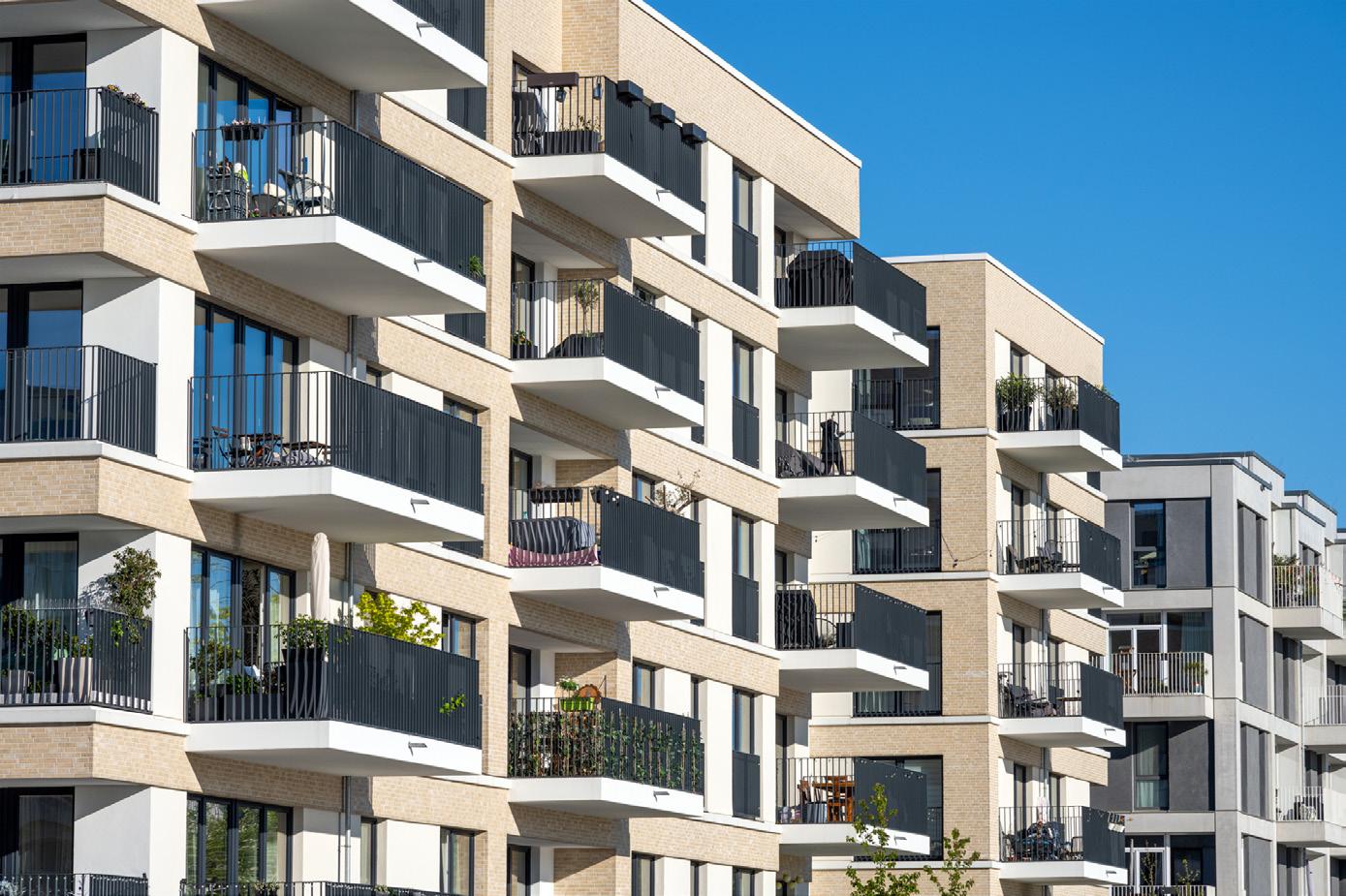


• Corporate Counsel
• Assessment Collection & Recovery
• Governing Document Interpretation & Enforcement
Document Restatement & Amendment


